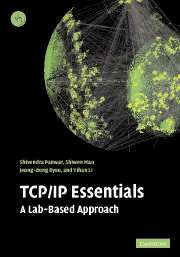Book contents
- Frontmatter
- Contents
- Preface
- Acknowledgements
- General conventions
- List of abbreviations
- 0 TCP/IP overview
- 1 Linux and TCP/IP networking
- 2 A single segment network
- 3 Bridges, LANs and the Cisco IOS
- 4 Static and dynamic routing
- 5 UDP and its applications
- 6 TCP study
- 7 Multicast and realtime service
- 8 The Web, DHCP, NTP and NAT
- 9 Network management and security
- References and further reading
- Appendix A Instructor's guide
- Appendix B Initial configuration of the routers
- Appendix C Source code
- Appendix D List of key requests for comments (RFC)
- Index
7 - Multicast and realtime service
Published online by Cambridge University Press: 05 June 2012
- Frontmatter
- Contents
- Preface
- Acknowledgements
- General conventions
- List of abbreviations
- 0 TCP/IP overview
- 1 Linux and TCP/IP networking
- 2 A single segment network
- 3 Bridges, LANs and the Cisco IOS
- 4 Static and dynamic routing
- 5 UDP and its applications
- 6 TCP study
- 7 Multicast and realtime service
- 8 The Web, DHCP, NTP and NAT
- 9 Network management and security
- References and further reading
- Appendix A Instructor's guide
- Appendix B Initial configuration of the routers
- Appendix C Source code
- Appendix D List of key requests for comments (RFC)
- Index
Summary
We are now in a transition phase, just a few years shy of when IP will be the universal platform for multimedia services.
H. SchulzrinneObjectives
Multicast addressing.
Multicast group management.
Multicast routing: configuring a multicast router.
Realtime video streaming using the Java Media Framework.
Protocols supporting realtime streaming: RTP/RTCP and RTSP.
Analyzing captured RTP/RTCP packets using Ethereal.
IP multicast
IP provides three types of services, i.e., unicast, multicast, and broadcast. Unicast is a point-to-point type of service with one sender and one receiver. Multicast is a one-to-many or many-to-many type of service, which delivers packets to multiple receivers. Consider a multicast group consisting of a number of participants, any packet sent to the group will be received by all of the participants. In broadcasts, IP datagrams are sent to a broadcast IP address, and are received by all of the hosts.
Figure 7.1 illustrates the differences between multicast and unicast. As shown in Fig. 7.1(a), if a node A wants to send a packet to nodes B, C, and D using unicast service, it sends three copies of the same packet, each with a different destination IP address. Then, each copy of the packet will follow a possibly different path from the other copies. To provide a teleconferencing-type service for a group of N nodes, there need to be N(N - 1)/2 point-to-point paths to provide a full connection.
- Type
- Chapter
- Information
- TCP/IP EssentialsA Lab-Based Approach, pp. 134 - 158Publisher: Cambridge University PressPrint publication year: 2004



